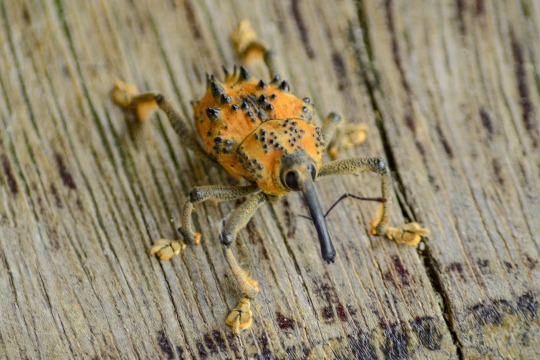#yellow spined weevil
Photo
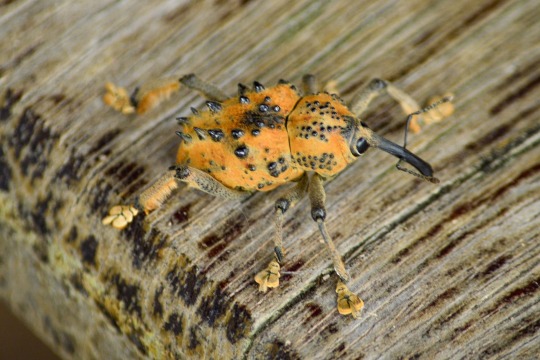

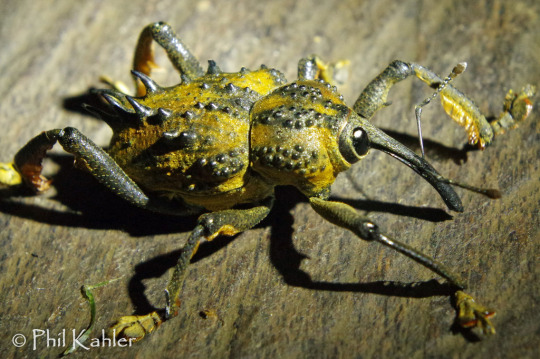
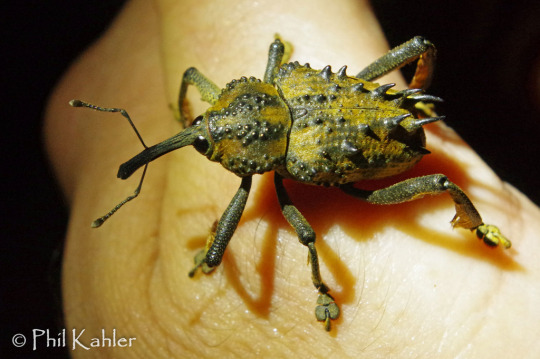
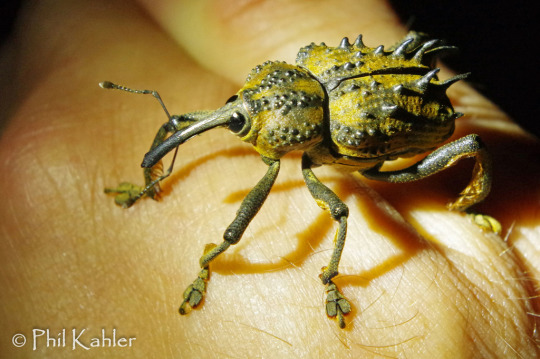

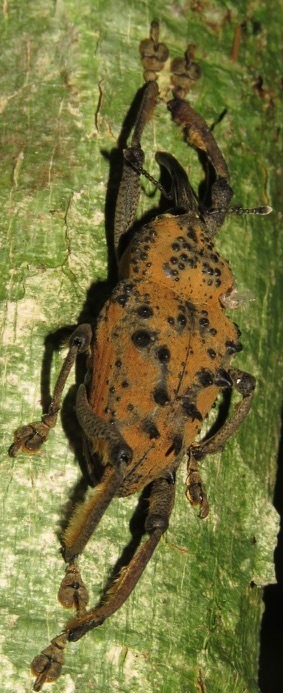
Yellow spined weevil, Ozopherus muricatus, Curculionidae
Found in South America
Photos 1-2 by libi2, 3-5 by philkahler, and 6-7 by birdernaturalist
#animals#curators on tumblr#insects#bugs#beetle#weevil#yellow spined weevil#one nice bug#get a load of those beetle peetles!!
6K notes
·
View notes
Text
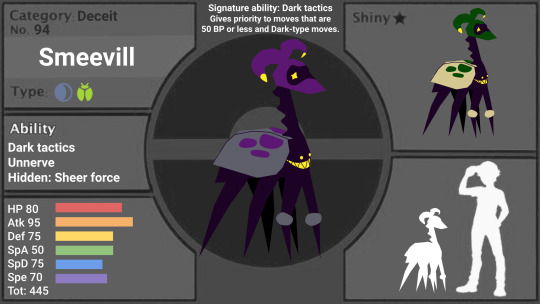
#94: Smeevill- The false purple head on top of Smeevill’s extended spine can be wiggled just above bushes to lure in stronger Pokémon hoping for an easy meal. As these stronger predators attack the lure, Smeevill’s true mouth unhinges to gobble them up. Smeevill can fly for short distances, but prefers to walk. This nocturnal Pokémon can barely be spotted at night, though the yellow sensory organs on its false head glow faintly to attract prey. If Smeevill is caught off guard, it is almost defenseless. (Name from “smirk”, “smile”, and “weevil”)
#smeevill#94#pokemon#fakemon#we NEED a giraffe weevil pokemon!!!!#but until we get a real giraffe weevil pokemon here's smeevill!
2 notes
·
View notes
Photo

I thought I'd do a bit of redrawing, and went back to this old thing. Good old "Amalgamation", which, for those who didn't see the original, was my self challenge to fuse every one of Ben's aliens he has used (From the Original Series to Omniverse). I mostly just polished it up, gave it brighter colours and adjusted some parts, even rearrange a thing or two. It's interesting looking back and remaking an old drawing, to see how I've improved. But I hope you enjoy this! I do also apologies if some aliens don't show as well as others, there was only so much I could do.
I wanna note off a few things for Amalgamation. First and foremost, this form is a mess, not something Ben can control, mostly just becoming a wild and rampaging monster. All the DNA just messes with his head too much to properly understand (Me and my friend even once wrote a story where this was Ben's EVO form). I imagine he can't use every single power here, or that many of them aren't as powerful as they should be, like how Kevin's mutations kind of work. E.G He's not gonna have straight up God powers from Alien X, not that he would know how to use them, but the energy from Alien X is what powers this form, or else it would probably be mush. Another example is Cannonbolt, as I'm sure this thing can not curl into a perfect ball, though it can still curl up and roll in a...strange shape. But with so many powers, and his wild mind, Amalgamation is still highly dangerous.
I'll also list off the aliens and where you can find their parts, unless you wanna try and spy them out yourself!
Heatblast - (Fire on top of his head)
Wildmutt - (Gills on the neck, which are also crossed with Ripjaw's gills, and orange fluff on the front legs)
Diamondhead - (Spikes of diamonds from on his back)
XLR8 - (Almost the entire tail)
Grey Matter - (His eyes are a cross between Grey Matter and Chamalien)
Four Arms - (Red top part of the arms)
Stinkfly - (Stinger that is also crossed with Alien X)
Ripjaws - (Lure hanging from head, and part of the tail is covered with his tail changing thing)
Upgrade - (His neck hold Upgrade's pattern)
Ghostfreak - (The tendrils coming out his stomach)
Cannonbolt - (Pad from on his hip/back leg)
Wildvine - (The crest is a mix of Wildvine and Lodestar)
Spitter - (His mouth is a mix of Blitzwolfer and Spitter)
Buzzshock - (Bolts on the arms)
Arctiguana - (Two blue spines on the tail)
Blitzwolfer - (Head and mouth mixed with other aliens)
Upchuck - (The three tongues coming out of his mouth)
Snare-Oh - (The cloth tendrils attached to his stomach)
Frankenstrike - (Two plugs on his chest, and the stitch pattern at the top of his front legs)
Ditto - (The little black stubs on the side of his head)
Way Big - (The discs on his wrists, and probably adds to the size)
Eye Guy - (Top of front legs, both being his skin and eye)
Swampfire - (Red leaves on top of front legs
Echo Echo - (Cords attached around the neck/throat area, connected to crest)
Humungosaur - (Front feet are a cross between Humungosaur and Armodrillo)
Jetray - Yellow horns on head, connected to Ripjaw's lure)
Big Chill - (Largest wings, that have purple patches from Pesky Dust)
Chromastone - (Magenta crystals on back feet)
Brainstorm - (Head shell that can split in two)
Spider Monkey - (Mixed with Blitzwolfer's head, mostly shown with the style of cheek fur)
Goop - (On the heels of the back feet)
Alien X - (Starry texture mixed with Stinkfly's stinger)
Lodestar - (Head crest mixed with Wildvine)
Rath - (Claws on front feet)
Nanomech - (Back feet mixed with Crashhopper)
Water Hazard - (Hands mixed with Way Big's discs, along with Whampire's claw shape)
AmpFibian - (Blue neck flaps, that hold Gravattack's core)
Armodrillo - (Front feet mixed with Humungosaur)
Terraspin - (Torso his skin, with his wind holes along the side of his body)
NRG - (Radioactive holes on neck, right next to the omnitrix)
Fasttrack - (Face mask like fur around the eyes)
Clockwork - (Part of the back legs that connect the feet and legs together)
Chamalien - (Eyes that are mixed with Grey Matter)
Eatle - (Long fin like horn on stop of head)
Juryrigg - (Tail tip right above Stinkfly's stinger)
Shocksquatch - (Middle section of arms, the black and white spiked fur)
Feedback - (Cords/plugs on the back of his neck)
Bloxx - (Lego blocks on the front legs)
Gravattack - (Core located on AmpFibian's flaps)
Crashhopper - (Back legs mixed with Nanomech)
Ball Weevil - (His buggy legs along the side of the torso)
Walkatrout - (Fin on the back of the neck, between the crest)
Pesky Dust - (Back wings, and the purple patches found on all wings)
Mole-Stache - (Little freckles on his cheeks)
The Worst - (Top of the back legs, along with the lumps)
Kickin Hawk - (Claw on the elbows of the arms)
Toepick - (Spiked growths on the back legs)
Astrodactyl - (Front wings with Pesky Dust's purple pattern)
Bullfrag - (Lumpy chin under the tongues)
Atomix - (Cylinders on the front legs, connecting the feet)
Gutrot - (Gas pod on the top of his neck, right under his throat)
Whampire - (Mixed with Water Hazard's claws, and green flaps under armpit)
#This thing takes so much work to draw#The painnnn#Ben 10#ben 10 omniverse#ben 10 original series#ben 10 alien force#ben 10 ultimate alien#Ben 10 Ben Tennyson#ben tennyson#Ben 10 Alien#Ben 10 Alien Fusion#Alien Fusion#ben 10 fan alien#B10#My Art
51 notes
·
View notes
Text
24 February - 14 March
Tomorrow is the Ides of March...what else can happen?
It’s been a busy few weeks in the garden and I’ve been to Antwerp and up to Gresgarth Hall, so a lot to report.
I re-mounted a Platycerium for the first time. It was interesting to see how they pile up on each other and how easy it was to pull off the dead ones and keep the one thriving one. Only two years ago this had only one pathetic little frond. I have nursed it back to a nice specimen and now have given it a new mounting. See photo under plant of the week below...
I enjoyed the last weekend of February in Antwerp with Jody and Steve who live there. It was the end of winter hours at work, so I was able to get away on the 15.00 train. We had a nice weekend.
The first of March brought us back to summer working hours (08.00 to 17.00 Monday through Thursday and 08.00 to 16.00 Friday). I replaced some raised bed wood that had rotted away in the pharmaceutical area.
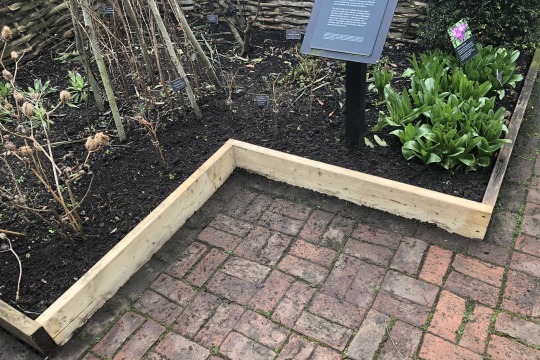
We had two days of students installing art all around the garden for their course. It was fun to see it installed. It was only up for two days, unfortunately.

Last weekend I went up to Gresgarth Hall as a guest of Arabella and Mark Lennox-Boyd. I work on the database for the arboretum at Gresgarth. I met the new members of the gardening staff and upgraded their databases. Gresgarth is a beautiful place to escape London (and CoVid-19).
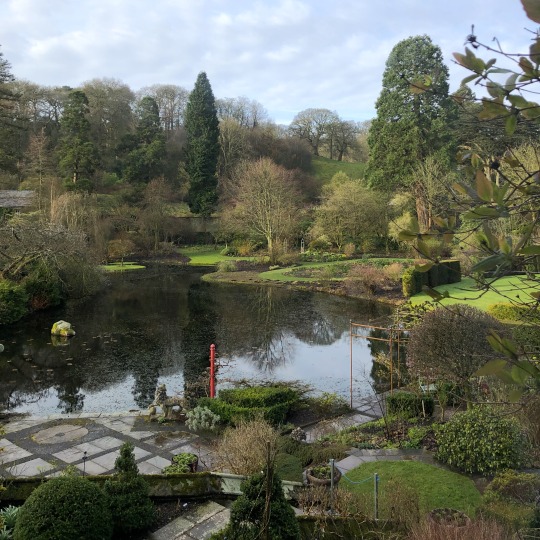

Monday morning at 06.13 I took a photo, through the bus window, crossing Putney Bridge on my way to work.
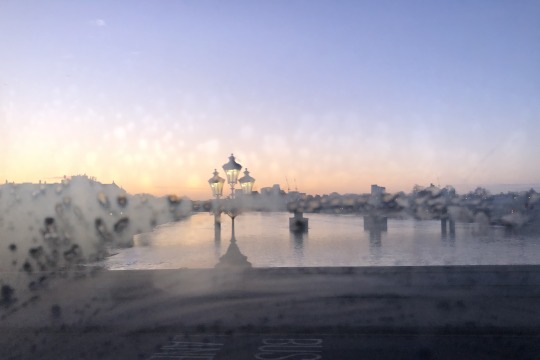
Later that day, one of our volunteers, Charlotte Lorimer, sent me this... Amazing!
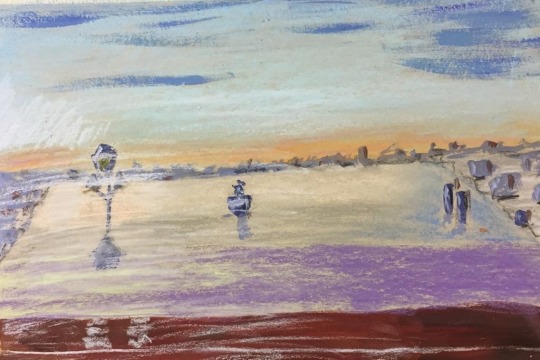
This past week I spent three days working on turf, so by Thursday, with sore chest muscles, of course I initially equated that with ‘breathing difficulties’. I stopped, and realised I just had sore muscles. Ah, how CoVid-19 is playing with my mind. I then had an opportunity to add my own art to the garden. I was asked to try to protect new grass seed from birds, this is what I came up with...

We are growing bananas from seed for the first time and this is a photo of them germinating on 3 March and again, one week later on 10 March.
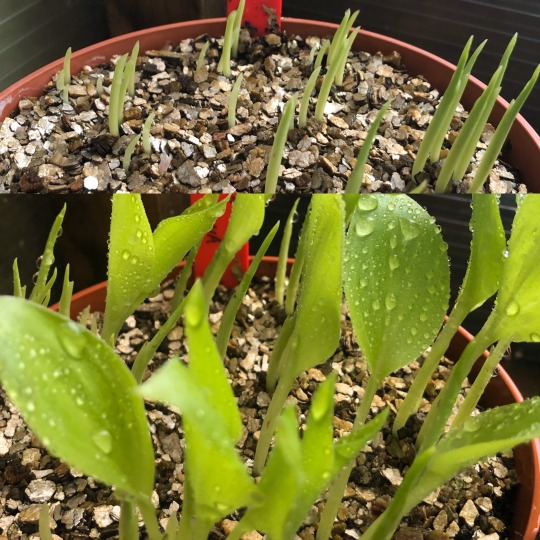
A volunteer donated a tablet to the garden so we will be able to use our database in the garden, once I figure out how to set it up! This is very exciting and should save us a lot of time. We expressed out huge gratitude to the wonderful volunteer who made this possible.
There is a lot of yellow in the garden at the moment, one of the showiest is Forsythia x intermedia ‘Beatrix Farrand’ which are located by the Embankment gate.

Plant ident on winter twigs by Joe:
Betulaceae Betula pendula
Betulaceae Carpinus betulus
Betulaceae Corylus avellana
Cornaceae Cornus sanguinea
Fagaceae Castanea sativa
Fagaceae Fagus sylvatica
Grossulariaceae Ribes nigrum
Rosaceae Prunus avium
Sapindaceae Acer griseum
Sapindaceae Aesculus hippocastanum
Plant of the week 28 February
Polypodiaceae Platycerium bifurcatum (Cav.) C. Chr.

common name(s) - common staghorn fern, common stag's horn fern, Australian elk's horn fern, elkhorn fern, antelope ears
synonym(s) - Acrostichum bifurcatum Cav.; Alcicornium bifurcatum (Cav.) Underw.
conservation rating - none
native to - Eastern Australia & New Caledonia
location - tropical corridor, accession 2008-0538, and fernery, accession 2008-0537
leaves - heart-shaped sterile fronds and grey-green, arching, fertile fronds to 900mm long, forked into strap-shaped segments, bearing brown spore patches beneath the tips
flowers - none
habit - evergreen, epiphytic fern
habitat - a bracket epiphyte occurring in and near rainforests
pests - scale insects
disease - generally disease-free
hardiness - to 1ºC (H2)
soil - epiphyte
sun - part shade, sheltered
propagation - sow spores when ripe or detach plantlets
pruning - none
nomenclature - Polypodiaceae - polypodium - many-feet, Dioscorides’ reference to the rhizome growth pattern, polypody; Platycerium - broad-horned, the stag’s-horn-like, dichotomous lobing of the fertile fronds; bifurcatum - divided into equal limbs
NB - AGM
References, bibliography:
Gledhill, David, (2008) “The Names of Plants”, fourth edition; Cambridge University Press; ISBN: 978-0-52168-553-5
IUCN [online] http://www.iucnredlist.org/search [14 Mar 20]
Missouri Botanical Garden [online] http://www.missouribotanicalgarden.org/PlantFinder/PlantFinderDetails.aspx?kempercode=b615 [14 Mar 20]
Plant List, The [online] http://www.theplantlist.org/tpl1.1/record/tro-50050265 [14 Mar 20]
Plants of the World [online] http://plantsoftheworldonline.org/taxon/urn:lsid:ipni.org:names:17177460-1 [14 Mar 20]
Royal Horticultural Society [online] https://www.rhs.org.uk/plants/details%3Fplantid%3D1488 [14 Mar 20]
Wikipedia [online] https://en.wikipedia.org/wiki/Platycerium_bifurcatum [14 Mar 20]
Plant ident of Jess’s favourites in the dicotyledon beds:
Apiaceae Ferula communis subsp. communis
Asteraceae Scolymus hispanicus
Asteraceae Serratula shawii
Caryophyllaceae Gypsophila acutifolia
Cistaceae Citrus trifoliata
Fabaceae Coronilla valentina subsp. glauca 'Citrina'
Fabaceae Glycyrrhiza yunnanensis
Ranunculaceae Clematis serratifolia
Rhamnaceae Paliurus spina-christi
Solanaceae Eriolarynx australis x Eriolarynx fasciculata
Plant of the week 6 March
Boraginaceae Echium candicans L.f.

common name(s) - pride of Madeira
synonym(s) - Argyrexias candicans Raf.; Echium brachyanthum Hornem.; E. candicans var. noronhae Menezes; E. cynoglossoides Desf.; E. densiflorum DC.; E. macrophyllum Lehm.; E. maderense Steud.; E. marianum Boiss.; E. pallidum Salisb.; E. pavonianum Boiss.; E. truncatum auct.
conservation rating - Data Deficient
native to - Madeira, Portugal
location - glasshouse two Macaronesian plants, accession 1991-0343
leaves - grey-hairy lance-shaped evergreen leaves
flowers - dense terminal spike-like panicles of white, pale or deep blue flowers in spring and summer
habit - bushy biennial sub-shrub
habitat - forest, rocky areas (e.g. inland cliffs, mountain peaks), shrubland
pests - outdoors slugs; indoors glasshouse whitefly, glasshouse red spider mite, vine weevils
disease - generally disease-free
hardiness - to 5ºC (H1c)
soil - under glass, grow in a loam-based potting compost, in full light; water freely when in growth, sparingly in winter. Outdoors, grow in moderately fertile, well-drained soil in full sun. Protect from winter frost in situ with horticultural fleece
sun - full sun, sheltered
propagation - seed at 13 to 16°C in summer, overwintering seedlings at 5 to 7°C
pruning - none
nomenclature - Boraginaceae - borago - shaggy-coat, burra with feminine suffix (the leaves); Echium - viper, a name used by Dioscorides for a plant to cure snakebite, viper’s bugloss Echium vulgare; candicans - white, hoary-white, with white woolly hair, present participle of candico
NB - in California, it is an invasive species. It is removed from native plant communities as part of habitat restoration efforts in coastal parks such as the Golden Gate National Recreation Area. In New Zealand it is a common garden escapee onto road-side verges and shingle banks throughout the drier parts of both the North and the South Islands. In the state of Victoria, Australia, it is considered to be a high weed risk and an alert has been posted by the Department of Primary Industries.
References, bibliography:
Gledhill, David, (2008) “The Names of Plants”, fourth edition; Cambridge University Press; ISBN: 978-0-52168-553-5
IUCN [online] https://www.iucnredlist.org/species/162036/115869493 [14 Mar 20]
Plant List, The [online] http://www.theplantlist.org/tpl1.1/record/kew-2784037 [14 Mar 20]
Plants of the World [online] http://plantsoftheworldonline.org/taxon/urn:lsid:ipni.org:names:115594-1 [14 Mar 20]
Royal Horticultural Society [online] https://www.rhs.org.uk/Plants/6290/i-Echium-candicans-i/Details [14 Mar 20]
Wikipedia [online] https://en.wikipedia.org/wiki/Echium_candicans [14 Mar 20]
Plant ident on plants from Macaronesia by Louisa:
Arecaceae Phoenix canariensis
Asparagaceae Dracaena draco
Asteraceae Argyranthemum frutescens
Asteraceae Schizogyne sericea
Athyriaceae Diplazium caudatum
Boraginaceae Echium wildpretii
Crassulaceae Aeonium spathulatum
Lauraceae Laurus azorica
Pinaceae Pinus canariensis
Plantaginaceae Plantago famarae
Plant of the week 13 March
Rosaceae Prunus spinosa L.

common name(s) - blackthorn, sloe, sloe plum, buckthorn, bullace, skeg, snag
synonym(s) - Druparia spinosa Clairv.; Prunus acacia Crantz ex Poir.; Prunus acacia Crantz; Prunus acacia-germanica Crantz; Prunus domestica var. spinosa (L.) Kuntze
conservation rating - Least Concern
native to - Europe, Morocco, Algeria, Tunisia, Turkey, Syria & Iran
location - useful garden - survival bed, accession 2017-0263
leaves - dark green, ovate leaves
flowers - small white flowers in early spring, followed by ovoid, bloomy black fruits 15mm across
habit - small thorny deciduous tree to 3m tall and 3m wide
habitat - shrubland, artificial/terrestrial, rocky areas (e.g. inland cliffs, mountain peaks), forest
pests - aphids, caterpillars, bullfinches
disease - silver leaf, blossom wilt
hardiness - to <-20ºC (H7)
soil - any moist well-drained soil
sun - full sun
propagation - sowing the stones shallowly (no more than their own length deep) in a well-drained growing medium. In order to germinate, the stones must be exposed to a period of cold for approximately two months. This can be achieved by placing them in a bag of moist sand in a fridge. Semi-ripe cuttings can be taken in late summer. Blackthorn tolerates most soils, except acidic ones, but does not perform well if shaded. Once it is established it is a tough, resilient plant
pruning - in mid-summer if silver leaf is a problem
nomenclature - Rosaceae - rosa - the Latin name for various roses; Prunus - the ancient Latin name for a plum tree; spinosa - spiny, with spines
NB - flavouring for alcoholic beverages (sloe gin), when tea derived from Camellia sinensis (a commonplace drink today) was a very expensive product, the young leaves of blackthorn were dried and used as a replacement for, or to adulterate, the more expensive tea. Blackthorn wood has been used to make walking sticks, clubs and hay-rake teeth. A shillelagh is a highly polished stick of blackthorn wood that was made and used in Ireland, and a blackthorn walking stick is still carried by commissioned officers of the Royal Irish Regiment. Blackthorn wood is especially hard and takes a high polish. The shillelagh was used in self defence and is now used in a form of traditional fighting or martial art. Stout sticks of blackthorn are highly prized since it is rare to find blackthorn grown to this size.
References, bibliography:
Gledhill, David, (2008) “The Names of Plants”, fourth edition; Cambridge University Press; ISBN: 978-0-52168-553-5
IUCN [online] https://www.iucnredlist.org/species/172194/19400568 [14 Mar 20]
Plant List, The [online] http://www.theplantlist.org/tpl1.1/record/rjp-43 [14 Mar 20]
Plants of the World [online] http://plantsoftheworldonline.org/taxon/urn:lsid:ipni.org:names:730297-1 [14 Mar 20]
Royal Horticultural Society [online] https://www.rhs.org.uk/Plants/14041/Prunus-spinosa/Details [14 Mar 20]
CoVid-19 is consuming me now. I altered the way I return home from work after Wednesday’s nighmarish journey on the underground. Trains were only every twenty minutes to Richmond so we were packed in like sardines. Now I’m walking across the river to Queenstown Road and catching a train. There is much more room on the train. I’m addicted to following the numbers on this incredible Johns Hopkins University website:

Stay healthy if you can, and self-isolate if necessary. This will pass in time...
0 notes
